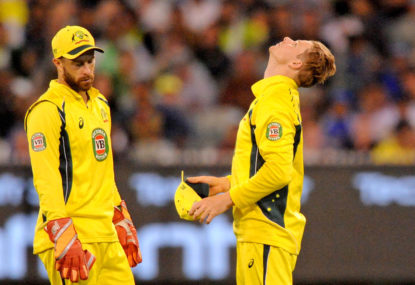When a team uses two part-time spinners inside the first 13 overs of an ODI innings, something has gone very, very wrong. That was just what happened yesterday as a result of curious selections in the Australian ODI team.
Australia bizarrely went into the second ODI against England with only three frontline bowlers, two of whom were rookies – 21-year-old Jhye Richardson making his debut, and 31-year-old Andrew Tye in just his second match.
Leg spinner Adam Zampa was dropped and replaced not by another spinner, nor by a paceman, but instead by a specialist batsman in Cameron White. Spin has become increasingly important in limited overs cricket in recent years, so much so that England yesterday bowled 24 overs of spin at the Gabba, a pitch historically the domain of pace bowlers.
In spite of this obvious global trend, Australia have continued to show a lack of respect for the role of spinners in white ball cricket. This culminated in the extraordinary sight yesterday of part-time offie Travis Head trundling to the crease after just six overs of England’s innings as Australia tried to defend a well-below-par total of 270.
The English batsman gleefully exploited this situation. Two of Head’s first four balls were hammered to the boundary and he bled 24 runs from his first three overs.
[latest_videos_strip category=”cricket” name=”Cricket”]
If Alex Hales and Jonny Bairstow were disappointed when Head was taken off, they needn’t have been because another rank spinner was into the attack one over later. In 442 games of professional cricket, across all three formats, Aaron Finch has taken just 19 wickets.
Yet here he was, just 12 overs into the England innings, bowling to two set batsmen. The likes of Zampa, Nathan Lyon and Ashton Agar must have been wincing as they watched from afar while Finch rolled out his nude deliveries.
What made this all even more gobsmacking is that, despite stacking their side with batsmen, Australia once again were exposed for the lack of flexibility in their ODI batting strategies.
Seemingly spooked by England’s ultra-aggressive batting unit, Australia fielded their longest batting line-up in recent memory.
So deep was Australia’s batting that at seven and eight they had two players who open for their States in 50-over cricket in White and ‘keeper-batsman Alex Carey.
The makeup of Australia’s XI suggested they intended to copy England’s batting strategy of attacking throughout the whole innings, as opposed to their usual approach of having lengthy periods of consolidation in between bursts of scoring.
At 1-91 after 15 overs Australia looked perfectly placed to pursue such an aggressive ploy. It wasn’t to be. In the following 24 overs, Australia scored just 107 runs at a dawdling strike rate of 4.45 runs per over.
To someone who didn’t watch the match, that equation would suggest Australia’s innings fell apart during that period, that they must have lost a cluster of wickets.
In reality they only lost two wickets in that time. So over the space of 24 overs, Australia made 2-107 on a very flat deck against an England attack which is solid, at best. Incredibly, harmless off spinner Moeen Ali and part time tweaker Joe Root were allowed to wheel down 14 overs for just 62 runs.

(AFP PHOTO / IAN KINGTON)
Australia needed to target England’s spinners in this match, after being too cautious against them in the first ODI. Yet they barely played a shot in anger across Moeen and Root’s 14 overs.
When Root trapped Steve Smith LBW, Australia were 2-110 off 19.4 overs and the run rate had dipped to 5.6 runs per over. It was clear one of the Australian batsmen needed to take on the English bowlers at this point, either the set batsman Aaron Finch or the incoming batsman.
On that pitch, against that English batting line-up, Australia’s threadbare attack was always going to struggle to defend anything less than 340, so risks needed to be taken.
Australia sent out at number four Travis Head, a young batsman who prefers to build an innings. At this stage they needed to either tell Finch to up the ante, or send out a more powerful hitter than Head and hand him that task.
What actually occurred was that Finch played the anchor role while first Head and then Mitch Marsh looked to work the ball around.
What, exactly, is the point of picking an extremely deep batting line-up if you’re going to bat conservatively? The obvious strategy across the first 35 to 40 overs was to always have one batsman accumulating and one going after the bowlers.
Instead Australia batted within themselves all the way up to the final ten overs by which time even a total of 300 was all but out of reach. And even 300 was never going to be enough on a road against a powerful batting side when you’ve only got three frontline bowlers and are using two part timers inside the first 13 overs.
Australia were a mess last night. A hot mess.






























































































